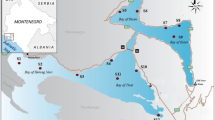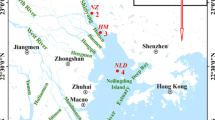Abstract
The total content of 35 elements has been determined in the bottom sediments of the Magnitogorsk reservoir using SR XRF, and the number of mobile forms of 10 metals has been assessed using atomic absorption spectrometry. The characteristics of incomplete data statistical analysis as well as the reasons of similarity and discrepancies of data obtained by different chemical analytical methods have been considered. Four paragenetic associations of elements have been revealed using principal component analysis in the structure of bottom sediments: those related to organic matter, to the pelite fraction, pollutants from Magnitogorsk Iron and Steel Works, and motor transport pollutants.
Similar content being viewed by others
References
T. S. Papina, Transport and the Peculiarities of Distribution of Heavy Metals in the Series: Water-Suspended Substance-Bottom Sediments of River Ecosystems (GPNTB SO RAN; IVEP SO RAN, Novosibirsk) [in Russian].
D. Yu. Nokhrin, Yu. G. Gribovskii, and N. A. Davydova, “Approaches to the Identification of Origin of Heavy Metals in Bottom Sediments and Standartization Problems: Case Study of Two SDPP Reservoirs in Ural Region,” Water Resources 35(5), 542 (2008).
Methodological Directions for Detection of Heavy Metals in Fodder and Plants and Their Mobile Compounds in Soils (TSINAO, Moscow, 1993) [in Russian].
V. B. Baryshev, Yu. P. Kolmogorov, and G. N. Kulipanov, “Synchrotron Radiation X-ray Fluorescence Element Analysis,” Zh. Analiticheskoi Khimii 41(3), 389 (1986).
Resident Risk Assessment software [Electronic resource]. Virginia Institute of Marine Science: [site]. [2010]. URL: http://www.vims.edu/research/departments/eaah/programs/risk/software/resident/in-dex.php (date of visit: 11.03.2010).
The R Project for Statistical Computing [Electronic resource]: [site]. [2010]. URL: http://www.r-project.org (date of visit: 11.03.2010).
L. Sachs, Statistisce Auswertungsmethoden (Springer-Verlag, Berlin, 1972) [in Russian].
I. T. Jolliffe, Principal Component Analysis (Springer, New York, 2002).
Complex Report on the State of the Natural Environment of the Chelyabinsk Oblast in 2006 (Ministry for Radioactive and Ecological Safety of the Chelyabinsk Oblast, Chelyabinsk, 2007) [in Russian].
D. R. Helsel, “More Than Obvious: Better Methods for Interpreting Nondetect Data,” Environ. Science & Technology, No. 10, 419 (2005).
M. E. Ginevan and D. E. Splitstone, Statistical Tools for Environmental Quality Measurement (CRC Press LLC, Boca Raton, 2004).
S. V. Chernysheva, E. V. Sokol, and N. V. Maksimova, “The Kopeisk Coal Area: Redesign of Sources of Technogenic Dustiness,” in Mineralogy of Technogenesis-2005 (IMin UrO RAN, Miass, 2005), pp. 214–228 [in Russian].
Harmful Chemicals. Inorganic Compounds of Elements of Groups I–IV: Reference Book, Ed. by V. A. Filatova et al. (Khimiya, Leningrad, 1988) [in Russian].
L. Ya. Kizil’shtein, The Ecogeochemistry of Impurity Elements in Coals (SKNTs VSh, Rostov-on-Don, 2002) [in Russian].
R. Zinkute, E. Brannvall, and R. Taraskevicius, “Variation of Trace Element Accumulation in Topsoil Near the Vilnius-Kaunas Highway,” Geologija 58, 1 (2007).
G. V. Voytkevich, A. V. Kokin, A. E. Miroshnikov, and V. G. Prokhorov, Geochemistry Manual (Nedra, Moscow, 1990) [in Russian].
A. G. Ural’shin, A. P. Gavrilov, and M. A. Krayushkina, “Definition of Risk to Population Health of the City of Magnitogorsk from the Effects of Discharge of Stationary Sources of Atmospheric Air Pollution,” in Social-Hygienic Monitoring: Yesterday, Today, Tomorrow (FGUZ “Tsentr Gigieny i Epidemiologii Chelyabinskoi Oblasti”, Chelyabinsk, 2006), pp. 138–142 [in Russian].
N. A. Antipanova, V. S. Koshkina, K. N. Takhtina, and D. A. Zalozhkov, “Carcinogenic Risk to the Health of the Population Residing under the Conditions of a Developed Ferrous Metallurgy Industry,” in Social-Hygienic Monitoring: Yesterday, Today, Tomorrow (FGUZ “Tsentr Gigieny i Epidemiologii Chelyabinskoi Oblasti”, Chelyabinsk, 2006), pp. 142–146 [in Russian].
Author information
Authors and Affiliations
Corresponding author
Additional information
Original Russian Text © D.Yu. Nokhrin, Yu.G. Gribovskii, E.V. Sokol, N.A. Davydova, E.N. Nigmatulina, 2010, published in Sibirskii Ekologicheskii Zhurnal, 2010, Vol. 17, No. 4, pp. 671-680.
Rights and permissions
About this article
Cite this article
Nokhrin, D.Y., Gribovskii, Y.G., Sokol, E.V. et al. The microelemental composition of Magnitogorsk reservoir bottom sediments: Methodological aspects and paragenetic associations. Contemp. Probl. Ecol. 3, 487–494 (2010). https://doi.org/10.1134/S1995425510040132
Published:
Issue Date:
DOI: https://doi.org/10.1134/S1995425510040132




